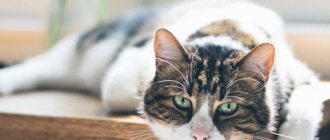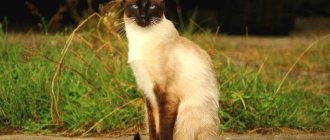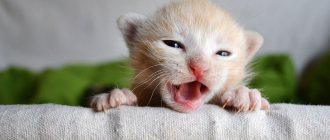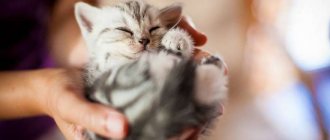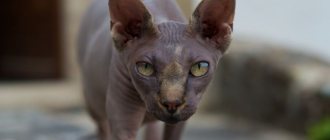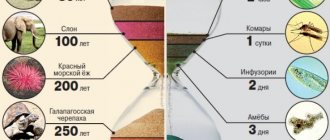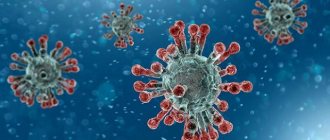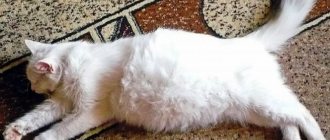Author: GEvpatoriya
30 June 2021 22:00
Community: Animals
Tags: cat veterinary useful articles
12326
1
On average, cats live 13–17 years at home, and 4–5 years in the wild and on the street. The lifespan of each cat is individual, does not depend on gender, is determined at the genetic level and changes under the influence of the environment. Life expectancy is influenced by living conditions, care, and the ability to receive timely help from a veterinarian.
0
Life cycle of mustachioed pets
The entire life cycle can be divided into 6 stages. Please note that they are all very conditional. Many cats remain playful and active even in their old age.
Infancy (up to 1 month)
Until 1 month, the kitten is completely dependent on the mother. In the first days after birth, he is blind and toothless, so communication with the outside world is very limited.
Childhood (up to 7-8 months)
With the appearance of the first baby teeth, the kitten begins to show more independence. He tries his first complementary foods and is actively learning new things.
At 2.5-4 months, the baby finally leaves his mother and learns to live independently. His molars gradually grow and puberty begins. By 7-8 months, female cats are already in their first heat, but they are still babies until their third heat.
Youth (up to 2 years)
At 1-1.5 years old males and female cats reach their first mating. They give birth to and raise their first offspring.
Youth (up to 4-5 years)
At this stage, breeders are actively breeding the breed. By age 5, most animals are removed for health reasons.
Maturity (up to 8 years)
The first behavioral changes appear. The cat becomes calmer and more reserved. She goes on crazy runs around the house less often, but still doesn't give up on games.
Old age (8-9 years and older)
At the final stage, there is a gradual attenuation of activity, an increase in sleep duration and the appearance of dental problems. The general well-being of the animal depends on the state of health.
In the absence of chronic diseases, significant changes are not observed. An elderly pet can be picky about food and show its devotion to its owner more clearly through affection and increased attention.
What determines the lifespan of cats?
The lifespan of cats depends on a number of external and internal factors. Some contribute to its increase, while others contribute to its reduction.
What promotes longevity
Anything that has a beneficial effect on health is responsible for longevity. These include:
- balanced diet;
- timely vaccination, deworming and treatment against external parasites;
- absence of hormonal surges;
- safe maintenance to prevent injury;
- Regular visits to the veterinarian for preventive purposes.
All of the above are completely inaccessible to street cats. For this reason, they always die earlier than domestic ones.
What shortens years of life
Factors that reduce immunity and undermine health have the opposite effect. These include:
- living in unfavorable conditions (frequent temperature changes, dampness, unsanitary conditions);
- lack of regular nutrition, consumption of low-quality foods and lack of vitamins;
- genetic predisposition to certain pathologies;
- frequent pregnancies and childbirths;
- infection;
- free range, fraught with injury or death under the wheels of vehicles;
- frequent and prolonged stress;
- excess weight, which provokes problems with the musculoskeletal system and hormonal disorders.
All of the above can significantly reduce the allotted years by more than 2 times.
Factors influencing health and longevity
According to experts, the quality of life of an animal directly affects its duration.
- Genetic properties of the breed. All breeding groups are divided into 3 categories - long-lived (maximum age 15 years or more), medium-lived (10-15 years) and the lowest level (less than 10 years). How long street cats live depends on the circumstances - among homeless animals there are also long-livers.
- Conditions of detention. The reasons for the reduction in life expectancy of cats may be an unsatisfactory living environment, for example, when the animal does not receive the necessary veterinary care.
- Nutrition. A high-quality diet and properly selected mineral and vitamin components can add a couple of active years to the life of domestic cats.
- Disease prevention. Each breed has a predisposition to certain ailments, and almost all cats also have heart and kidney problems. When neglected, these diagnoses are no longer curable and become chronic. Even young animals are not able to constantly cope with the resulting load and painful sensations. Such cats do not live long.
- Emotional background. The most subjective indicator, but many owners believe that life expectancy is influenced by the attitude of owners and family members, friendship with other four-legged pets, degree of training, general games and walks.
This is interesting! Among wild cat hybrids that live in enclosures, there are no long-livers.
How many years do street cats live?
Approximately 85% of animals born on the streets die as kittens. This occurs due to weakened immunity, low temperatures, infections, parasites and poisoning. Stronger individuals usually live up to 4-8 years.
The worst situation is for domestic cats that are lost or abandoned by their owners. Being unadapted to such harsh conditions, they die from stress, cold and hunger within the first 3 years.
Mature (7-10 years)
At this age, the cat will be the human equivalent of a human between forty and fifty. This means that the owner may notice that the pet begins to slow down and it is more likely to gain weight.
It is important to closely monitor their food intake to ensure they have the right amount for their activity level. To reduce food intake when sick, it is better to consult a veterinarian.
Life expectancy of cat breeds at home
Longevity directly depends on the breed. Most artificially bred breeds are characterized by hereditary diseases that reduce the number of years allotted. This explains why the average age of mongrel cats that have escaped human intervention is often 5 years older.
Average and maximum indicators: table
The average and maximum age indicators characteristic of purebred animals can be found in the example table. It presents the 10 most popular representatives of the cat family.
| Breed name | Lifespan | |
| Average | Maximum | |
| Siamese | 15 | 20 |
| Scottish | 15 | 20 |
| Russian blue | 14 | 19 |
| Bengal | 13 | 16 |
| Maine Coon | 12,5 | 16,5 |
| Persian | 10-17 | 20 |
| British | 12 | 16 |
| Siberian | 15 | 20 |
| Abyssinian | 12-15 | 20 |
| Sphinx | 13 | 14 |
Most of these breeds do not live to their maximum age due to chronic renal failure, urolithiasis, polycystic kidney disease and cardiovascular pathologies.
Long-lived breeds
Long-livers include all representatives of the Siamese-Oriental group, Maine Coons, Siberians and other aboriginal breeds. All of them were able to avoid direct human intervention in their long history of development and went through the most reliable selection - natural selection. Thanks to him, Aboriginal cats received strong immunity and good health.
Maximum age of a cat
The Guinness record holder is the long-lived cat Cream Puff, who lived a little over 38 years. Among the living, the leader in life expectancy is the British mongrel pet Lucy, she is already 43 years old. Such indicators are typical for Western countries, where pets are sometimes treated even better and more attentively than family members.
Which cats live the longest?
Naturally, breeders try to choose a breed not only by appearance, but also by life expectancy. It is normal to want your beloved pet to stay close to you for as long as possible. The leaders in life expectancy are Siamese, Bengal, Persian, Siberian and Maine Coon cats. The minimum age in our country for sphinxes is due to the fact that the climate is absolutely unsuitable for the breed, and home maintenance is rarely maintained at the required level.
- Home Remedies for Leg Pain Treatment
- How to fall asleep when you have a cough or cold
- 9 signs of heart disease that require you to see a doctor
How castration or sterilization affects longevity
Contrary to popular belief, surgery to deprive reproductive function does not shorten, but prolongs the life of your pet. This happens thanks to:
- softening of character (the cat stops getting into fights and looking for adventures);
- prevention of oncology and sexually transmitted diseases;
- absence of hormonal surges due to medications, pregnancy and childbirth.
Frequent birth and feeding of kittens greatly wears out the body. He suffers not only physically, but also emotionally. After sterilization, this problem completely disappears, as does the possibility of developing cancer. Thanks to the operation, the overall life expectancy is increased by 3 years.
The only disadvantage for castrated animals is their tendency to become obese. Due to a slower metabolism, they gain weight faster, so their diet must be strictly controlled.
Ways to help prolong the life of a pet
If your cat is approaching her final stage, don't despair. After all, for many, life after 8 years is just beginning. By following a number of recommendations, this period can be extended as long as possible.
Proper nutrition
Don't skimp on the quality of your products. Buy meat, vegetables and dairy products in trusted places or choose ready-made food of at least premium quality.
Be sure to follow the feeding schedule, avoiding overfeeding and handouts from the table. Remember that on a natural diet you must add vitamins prescribed by your veterinarian to your food.
Competent care
Avoid the formation of tangles and strong darkening of tooth enamel. Brush your pet 1-2 times a week and brush his teeth every month.
Also remember to keep your eyes and ears clean. Remove any secretions that accumulate in them and be sure to contact a veterinarian if an unpleasant odor or foreign matter appears.
Pay special attention to physical activity. Monitor your cat's weight and don't let him nap on the couch too often. Outdoor games improve health, promoting longevity.
Vaccinations and disease prevention
Most infections can be prevented through vaccination. The first vaccination followed by revaccination is given when the child reaches 2 months of age. With the onset of the year, the frequency of grafting reaches no more than 1 time per year.
In addition to viruses and bacteria, you should be wary of parasites and genetic pathologies. To prevent them, it is necessary to promptly treat with anthelmintic and acaricidal drugs and undergo an annual preventive examination at a veterinary clinic.
No stress
The family situation plays a big role. The absence of quarrels between owners and a reverent attitude towards the pet have a positive effect on mental health.
Sexual health
When participating in breeding, all rules must be strictly followed. Do not attempt to start your breeding career early or exceed the recommended birth rate. Bearing offspring is always accompanied by severe nervous tension and hormonal changes, so timely retirement is very important here. Otherwise, the animal risks not living to its allotted time.
If breeding and selling kittens is not part of your plans, sign up your pet for castration immediately after puberty. This will protect her from cancer and other dangerous complications associated with hormones. A similar choice should be made regarding the cat.
Requirements for the place of detention
Pets should be kept in a warm and clean environment. Locate the sleeping area away from drafts and prohibit your pet from sleeping on a tiled floor. To avoid hypothermia, be sure to accustom your cat to a bed or install an underground heating system.
Don't forget to change the litter in the tray, wash food bowls after each feeding and change the water daily. Remember that not only freshness is important, but also the absence of foreign impurities. Water must be purchased from a store or passed through a filter to remove any sediment it contains.
How to extend a cat's life
Every family sooner or later thinks that their beloved cat will not be with them forever. It’s better if the question “how to prolong a cat’s life” arises before the owner when their pet is still an immature kitten. So, cats live for many years if:
- the owner selects a balanced diet, including vitamin and mineral supplements, and does not overfeed the animal;
- the owner understands the importance of preventive examinations by a veterinarian and the need for vaccinations;
- at the first signs of illness, the cat is taken to the veterinarian for an appointment;
- the animal is encouraged to engage in regular physical activity at any age;
- maintain hygiene and follow the rules of care;
- take preventive measures against fleas, ticks and parasites;
- It is better to castrate the male and sterilize the female if the owner does not plan to engage in breeding work.
There is also a basic rule for many years: you need to love your cat and always find time for her.
Cat to human age ratio
The most popular method of converting a cat's age to a human age is 1 to 7. Despite this, it is the most unreliable. Instead, they are increasingly using a scheme with a slow growth rate. In it, 1 year is equated to 15 years, 2 years to 9, and each subsequent year to 4. That is, a one-year-old cat is a 15-year-old teenager, the same animal at the age of 2 is a 24-year-old independent man, and at 3 and 4 years, the age of the mustache is equated to 28 and 32 years, respectively.
Veterinarians usually adhere to the scheme from the international veterinary passport. According to him, the ratio is as follows:
| Cat age (years) | Human age (years) |
| 1 | 18 |
| 2 | 25 |
| 3 | 30 |
| 4 | 35 |
| 5 | 40 |
| 6 | 43 |
| 7 | 45 |
| 8 | 50 |
| 9 | 55 |
| 10 | 60 |
| 11 | 62 |
| 12 | 65 |
| 13 | 68 |
| 14 | 72 |
| 15 | 74 |
| 16 | 76 |
| 17 | 78 |
| 18 | 80 |
| 19 | 90 |
| 20 | 100 |
But here everything is very conditional. Maine Coons and Siberians have a very long adolescence, so at 4-5 years their psychological age is close to adolescence.
Street and yard cats
The life expectancy of free-ranging street cats is only 3-5 years. These indicators are relevant only among individuals that survived to adulthood.
Street kittens often die from the same viruses against which domestic kittens are vaccinated. It could be:
- panleukopenia;
- calicivirus;
- rhinotracheitis;
- protozoal infections - chlamydia and mycoplasmosis.
Undoubtedly, pets also get sick, but owners can take them to a veterinary clinic where they can get help. Neglected diseases lead to the death of kittens or their loss of vision, which is fatal for wild cats.
The main causes of death for adult street cats are injuries and poisoning. An animal may not have time to escape from dogs, suffer from hooligans, eat poisoned bait, or drink antifreeze from hunger. Many ordinary cats die in the cold from hypothermia.
Not only cats born on the street are exposed to these dangers, but also domestic ones if the owners consider uncontrolled walking acceptable. The area of danger is not only the city, but also the dacha, where cats often “disappear”, or rather, let’s face it, they die.
For a pet who is accustomed to complete protection in an apartment, the street poses an even greater danger than for one who was able to grow up “in the wild.” Some absolutely domestic cats do not know that they should be afraid of dogs.
Self-walking cats in most Russian regions is also dangerous for owners. During the “walk” they can become infected with rabies and bring it to their owners. In this case, only emergency multiple vaccinations, which are not given to animals, help people to save themselves from inevitable death.
Determining the age of a kitten or adult cat
It is impossible to determine the exact age of an animal taken from the street, but an approximate age is not at all difficult. Veterinarians determine it by external signs: the condition of the teeth, fur, mustache, eyes and musculoskeletal system.
The older the cat, the more worn out his teeth are. Very old individuals may lack incisors and fangs. Also, with aging, dulling and thinning of the coat is noted. By the age of 10, the first gray hair appears, spreading from the fur coat even to the mustache. The animal's eyes become dull and the spine begins to sag. The gait loses its former confidence, and the claws lose flexibility.
